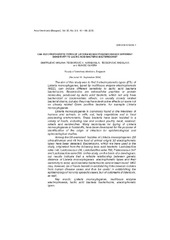Приказ основних података о документу
Can electrophoretic types of listeria monocytogenes induce different sensitivity to lactic acid bacteria bacteriocins?
Mogu li elektroforetski tipovi Listerya monoytogenes usloviti različitu osetljivost prema bakteriocinima mlečno-kiselinskih bakterija?
| dc.creator | Dimitrijević, Mirjana | |
| dc.creator | Teodorović, Vlado | |
| dc.creator | Karabasil, Nedjeljko | |
| dc.creator | Teodorović, Radislava | |
| dc.creator | Bunčić, Olivera | |
| dc.date.accessioned | 2020-06-03T12:53:59Z | |
| dc.date.available | 2020-06-03T12:53:59Z | |
| dc.date.issued | 2005 | |
| dc.identifier.issn | 0567-8315 | |
| dc.identifier.uri | https://vet-erinar.vet.bg.ac.rs/handle/123456789/322 | |
| dc.description.abstract | The aim of this study was to find if electrophoretic types (ETs) of Listeria monocytogenes, typed by multilocus enzyme electrophoresis (MEE), can induce different sensitivity to lactic acid bacteria bacteriocins. Bacteriocins are extracellular peptides or protein molecules, produced by lactic acid bacteria, which not only have bactericidal or bacteriostatic effects, on usually closely related bacterial strains, but also they may have destructive effects on some not so closely related Gram positive bacteria, for example Listeria monocytogenes. Listeria monocytogenes is commonly found in the intestines of humans and animals, in milk, soil, leafy vegetables and in food processing environments. These bacteria have been isolated in a variety of foods, including raw and cooked poultry, meat, seafood, salads and sandwiches. Many techniques for typing of Listeria monocytogenes in foodstuffs, have been developed for the purpose of identification of the origin of infection for epidemiological and epizootological studies. Among the 98 examined isolates of Listeria monocytogenes (50 clinical/human and 48 from food of animal origin) 32 electrophoretic types have been detected. Bacteriocins, which we have used in the study, originated from the following lacic acid bacteria: Lactobacillus sake 148, Lactococcus UW, Lactobacillus sake 706, Pediococcus 347 and Lactobacillus sake 265. In this study, on the basis of a dendogram, our results indicate that a reliable relationship between genetic distance of Listeria monocytogenes electrophoretic types and their sensitivity to lactic acid bacteria bacteriocins cannot been found. MEE may, however, be of future benefit in establishing links between isolates from human disease cases and thus be useful in establishing the epidemiology of not only sporadic cases, but of outbreaks of listeriosis, as well. | en |
| dc.description.abstract | Cilj ovog ispitivanja je bio da se ustanovi da li elektroforetski tipovi (ET) Listeria monocytogenes, tipizirani metodom multilokus enzimske elektroforeze, mogu usloviti različitu osetljivost prema bakteriocinima mlečno-kiselinskih bakterija. Bakteriocini su ekstracelularno oslobođeni peptidi, ili proteinski moiekuli, stvoreni od strane mlečno-kiselinskih bakterija, koji imaju baktericidne ili bakteriostatske efekte, obično prema srodnim bakterijskim vrstama, ali takođe mogu imati i destruktivne efekte prema nekim manje srodnim Gram pozitivnim bakterijama, kao što je Listeria monocytogenes. Listeria monocytogenes se uglavnom nalazi u crevima ljudi, u mleku, zemljištu, listastom povrću i proizvodnoj okolini. Ova bakterija je takođe izolovana iz razne hrane, uključujući sirovu i kuvanu živinu, meso, morske plodove, salate i sendviče. U svrhu identifikacije izvora infekcije za epidemiološke i epizotološke studije, razvijeno je mnogo tehnika za tipizaciju Listeria monocytogenes iz hrane. Među 98 izolata L. monocytogenes (50 kliničkih/humanih i 48 iz namirnica animalnog porekla) ustanovljeno je 32 elektroforetska tipa. Bakteriocini koji su korišćeni u studiji, poreklom su od sledećih mlečno-kiselinskih bakterija: Lactobacillus sake 148, Lactococcus UW, Lactobacillus sake 706, Pediococcus 347 and Lactobacillus sake 265. U ovom radu, na osnovu dendograma, naši rezultati uka-zuju da se ne može naći odgovarajuća povezanost između genetske distance elektroforetskih tipova L. monocytogenes i njihove osetljivosti prema bakteriocinima mlečno-kiselinskih bakterija. Multilokus enzimska elektroforeza (MEE) se može ubuduće koristiti za uspostavljanje veza među izolatima od obolelih ljudi i biti korisna za ustanovljavanje epidemiologije kako kod sporadičnih slučajeva, tako i kod epidemija listerioze. | sr |
| dc.publisher | Univerzitet u Beogradu - Fakultet veterinarske medicine, Beograd | |
| dc.rights | openAccess | |
| dc.source | Acta Veterinaria-Beograd | |
| dc.subject | Listeria monocytogenes | en |
| dc.subject | multilocus enzyme electrophoresis | en |
| dc.subject | lactic acid bacteria bacteriocins | en |
| dc.subject | electrophoretic types | en |
| dc.title | Can electrophoretic types of listeria monocytogenes induce different sensitivity to lactic acid bacteria bacteriocins? | en |
| dc.title | Mogu li elektroforetski tipovi Listerya monoytogenes usloviti različitu osetljivost prema bakteriocinima mlečno-kiselinskih bakterija? | sr |
| dc.type | article | |
| dc.rights.license | ARR | |
| dcterms.abstract | Карабасил, Неђељко; Димитријевић, Мирјана; Бунчић, Оливера; Теодоровић, Радислава; Теодоровић, Владо; | |
| dc.citation.volume | 55 | |
| dc.citation.issue | 2-3 | |
| dc.citation.spage | 161 | |
| dc.citation.epage | 169 | |
| dc.citation.other | 55(2-3): 161-169 | |
| dc.citation.rank | M23 | |
| dc.identifier.wos | 000229817500007 | |
| dc.identifier.doi | 10.2298/AVB0503161D | |
| dc.identifier.scopus | 2-s2.0-21344458375 | |
| dc.identifier.fulltext | https://vet-erinar.vet.bg.ac.rs/bitstream/id/898/321.pdf | |
| dc.type.version | publishedVersion |

